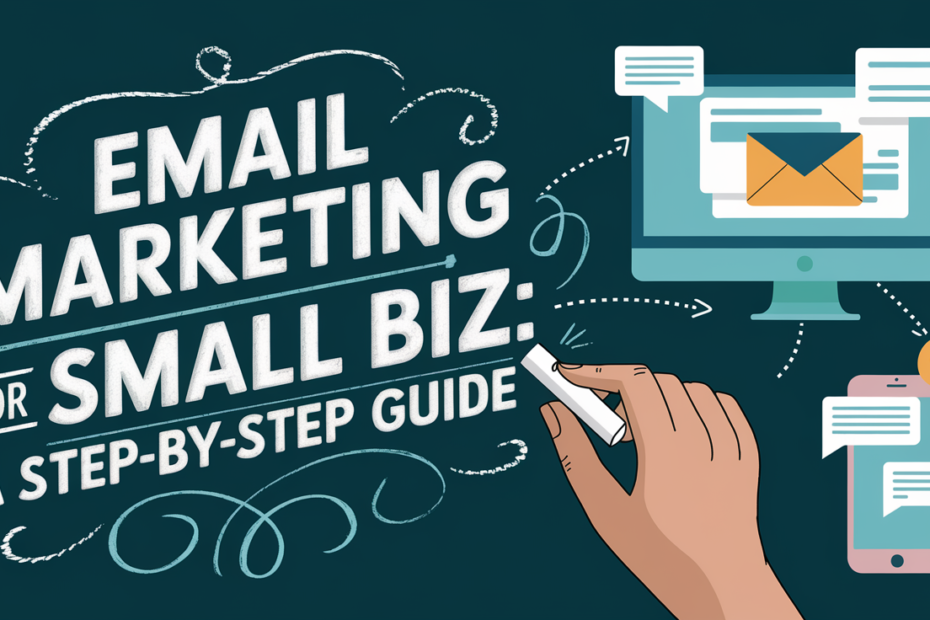Email marketing is one of the most powerful tools small businesses can use to attract, engage, and retain customers. Unlike social media, where algorithms decide who sees your content, emails land directly in your audience’s inbox. If done right, email marketing can drive consistent sales, build brand loyalty, and create strong customer relationships.
In this guide, we’ll take you through a step-by-step approach to email marketing for small businesses, ensuring you get the best results.
Table of Contents
Introduction to Email Marketing
What is Email Marketing?
Email marketing is the practice of sending targeted emails to potential or existing customers to promote products, services, or brand awareness. It’s a cost-effective strategy that allows businesses to connect directly with their audience.
Why is it Important for Small Businesses?
For small businesses, email marketing provides a high return on investment (ROI), averaging $42 for every $1 spent. It helps:
- Build relationships with customers
- Drive traffic to your website
- Increase sales and revenue
- Establish credibility and brand awareness
Getting Started with Email Marketing
Choosing the Right Email Marketing Platform
Popular platforms like Mailchimp, ConvertKit, and ActiveCampaign offer user-friendly tools to create, send, and track emails. Choose a platform based on:
- Your budget
- Features like automation, templates, and analytics
- Integration with your website and CRM
Setting Up Your Business Email
Avoid using free email providers (e.g., Gmail, Yahoo). Instead, use a professional business email (e.g., [email protected]) to build trust with subscribers.
Building Your Email List
Creating a High-Converting Lead Magnet
A lead magnet is a valuable freebie offered in exchange for an email address. Examples include:
- eBooks
- Discount codes
- Free courses or webinars
Using Signup Forms and Landing Pages
Embed email signup forms on your website, blog, and checkout pages. Design landing pages that highlight the benefits of joining your email list.
Growing Your List with Social Media and Website Traffic
Promote your lead magnet on social media and add a signup link in your Instagram bio, Facebook page, and YouTube descriptions.
Crafting the Perfect Email
Writing Engaging Subject Lines
Your subject line determines whether an email gets opened. Use curiosity, urgency, or personalization. Example:
❌ Check out our new offer
✅ Sarah, your exclusive 20% discount expires soon!
Structuring Your Email for Maximum Impact
- Greeting: Address the reader by name
- Hook: Grab attention in the first sentence
- Body: Keep it concise and engaging
- CTA (Call to Action): Tell them what to do next
Using Personalization and Segmentation
Segment your list based on location, purchase history, or interests. Personalized emails generate 6x higher transaction rates.
Types of Emails to Send
- Welcome Emails: Introduce new subscribers to your brand.
- Promotional Emails: Offer discounts, deals, or product launches.
- Newsletter Emails: Share industry tips, updates, and behind-the-scenes content.
- Re-engagement Emails: Win back inactive subscribers with a special offer.
Automating Your Email Campaigns
Setting Up Email Sequences
Automate follow-up emails to nurture leads. Example:
- Day 1: Welcome email
- Day 3: Share your best content
- Day 7: Offer a limited-time discount
Using Triggers and Workflows for Automation
Set up triggers based on user actions (e.g., abandoned cart, new sign-up) to send relevant emails automatically.
Analyzing and Optimizing Your Campaigns
Tracking Key Metrics
Monitor open rates, click-through rates, and conversions to measure success.
A/B Testing for Better Performance
Test different subject lines, email formats, and CTA buttons to see what works best.
Improving Deliverability and Avoiding Spam Filters
Use a professional email address, avoid spammy words (e.g., “FREE!!!”), and maintain a healthy sender reputation.
Best Practices for Email Marketing Success
- Optimize for mobile devices
- Stay consistent (weekly or bi-weekly emails)
- Ensure compliance with GDPR and CAN-SPAM laws
Common Email Marketing Mistakes to Avoid
- Buying email lists (leads become unresponsive)
- Ignoring analytics (no way to improve)
- Overloading subscribers with daily emails
Conclusion & Next Steps
Email marketing is a game-changer for small businesses. By following this guide, you can build a strong email list, create engaging content, and automate campaigns for maximum results. Start small, track your performance, and refine your strategy over time!
FAQs
1. How often should I send emails?
Aim for 1-2 times per week to stay consistent without overwhelming subscribers.
2. What’s the best time to send emails?
Research suggests Tuesday and Thursday mornings perform best, but test to see what works for your audience.
3. Can I use Gmail for email marketing?
No. Use a professional email marketing platform for bulk sending and tracking.
4. How do I avoid spam filters?
Avoid spammy words, use a professional email domain, and ensure your emails provide value.
5. What’s the best email marketing tool for beginners?
Mailchimp and ConvertKit are great beginner-friendly options with automation and analytics.
